Analysis of Stable Equilibrium and the Australian Economy
VerifiedAdded on 2020/04/07
|12
|1531
|134
Report
AI Summary
This report examines the concept of stable equilibrium within the context of the Australian economy. It begins by defining stable equilibrium in microeconomic terms, illustrating how market forces typically restore equilibrium. The report then transitions to a macroeconomic perspective, considering aggregate demand and supply. The core of the analysis focuses on key macroeconomic indicators for Australia, including GDP growth, inflation rates, and unemployment levels. Data from sources like the Australian Bureau of Statistics and the Reserve Bank of Australia are used to assess the economy's stability over time. The report also touches on government interventions, such as fiscal and monetary policies, and their role in maintaining economic stability, referencing Australia's response to the 2008 global financial crisis as a case study. The conclusion summarizes the state of the Australian economy and highlights the challenges related to long-term unemployment.
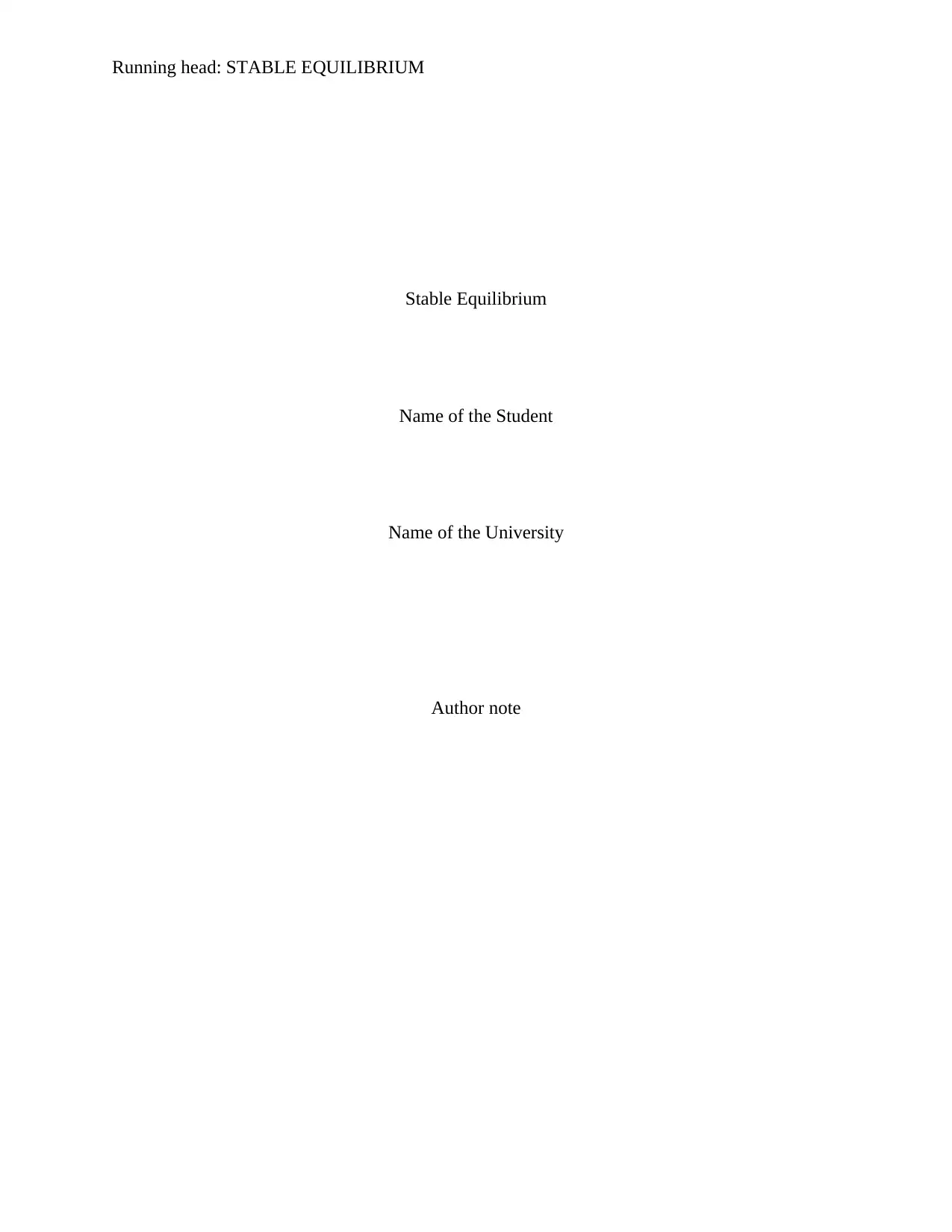
Running head: STABLE EQUILIBRIUM
Stable Equilibrium
Name of the Student
Name of the University
Author note
Stable Equilibrium
Name of the Student
Name of the University
Author note
Paraphrase This Document
Need a fresh take? Get an instant paraphrase of this document with our AI Paraphraser
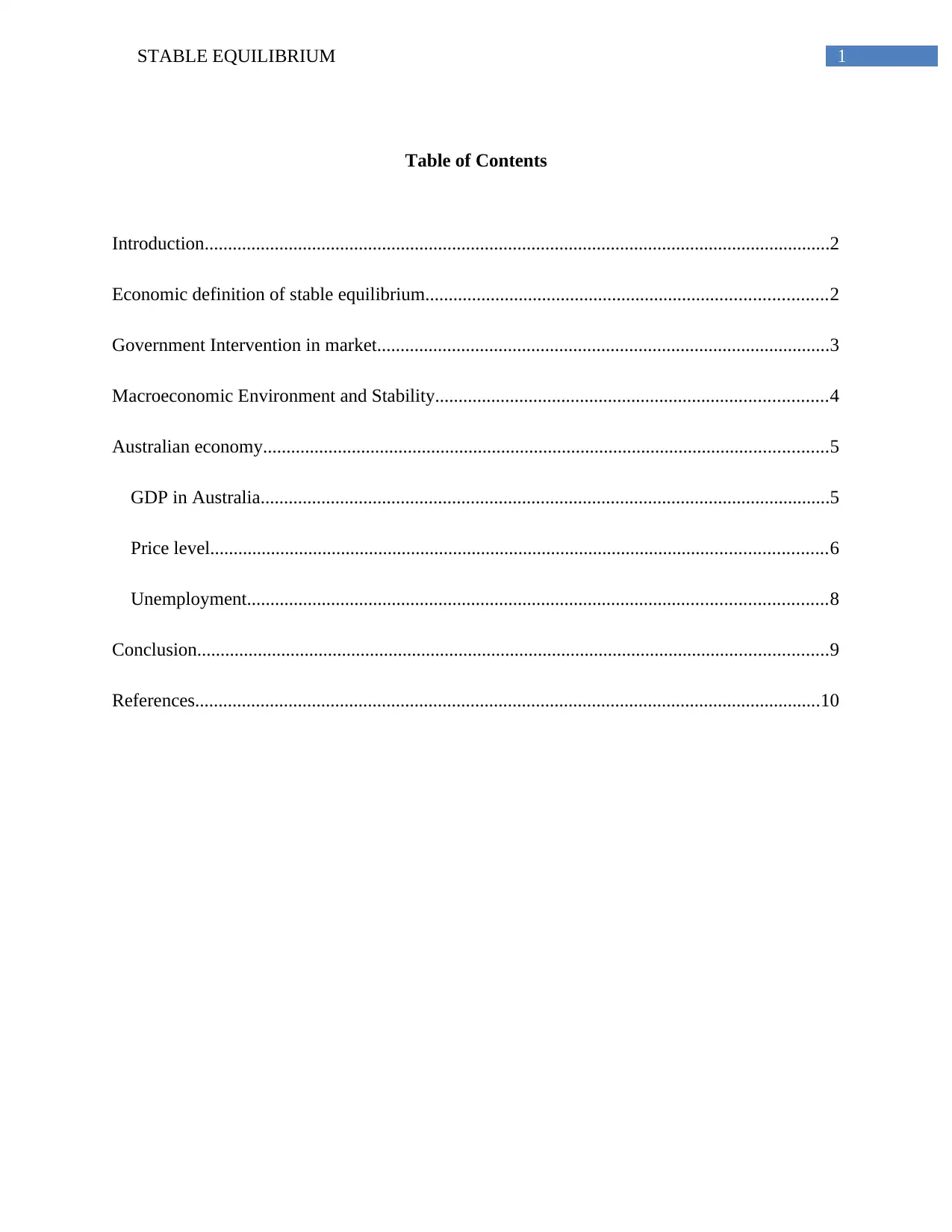
1STABLE EQUILIBRIUM
Table of Contents
Introduction......................................................................................................................................2
Economic definition of stable equilibrium......................................................................................2
Government Intervention in market.................................................................................................3
Macroeconomic Environment and Stability....................................................................................4
Australian economy.........................................................................................................................5
GDP in Australia..........................................................................................................................5
Price level....................................................................................................................................6
Unemployment............................................................................................................................8
Conclusion.......................................................................................................................................9
References......................................................................................................................................10
Table of Contents
Introduction......................................................................................................................................2
Economic definition of stable equilibrium......................................................................................2
Government Intervention in market.................................................................................................3
Macroeconomic Environment and Stability....................................................................................4
Australian economy.........................................................................................................................5
GDP in Australia..........................................................................................................................5
Price level....................................................................................................................................6
Unemployment............................................................................................................................8
Conclusion.......................................................................................................................................9
References......................................................................................................................................10
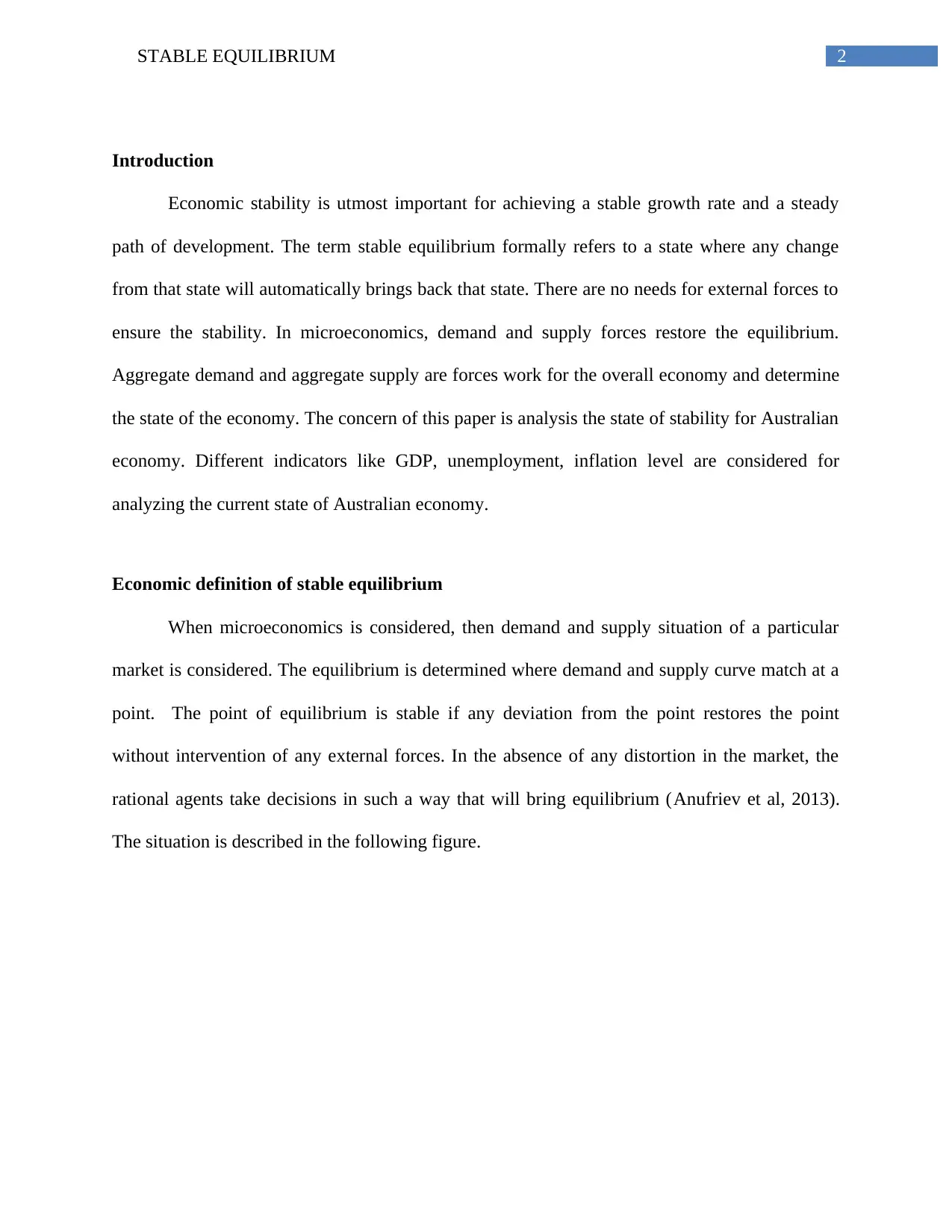
2STABLE EQUILIBRIUM
Introduction
Economic stability is utmost important for achieving a stable growth rate and a steady
path of development. The term stable equilibrium formally refers to a state where any change
from that state will automatically brings back that state. There are no needs for external forces to
ensure the stability. In microeconomics, demand and supply forces restore the equilibrium.
Aggregate demand and aggregate supply are forces work for the overall economy and determine
the state of the economy. The concern of this paper is analysis the state of stability for Australian
economy. Different indicators like GDP, unemployment, inflation level are considered for
analyzing the current state of Australian economy.
Economic definition of stable equilibrium
When microeconomics is considered, then demand and supply situation of a particular
market is considered. The equilibrium is determined where demand and supply curve match at a
point. The point of equilibrium is stable if any deviation from the point restores the point
without intervention of any external forces. In the absence of any distortion in the market, the
rational agents take decisions in such a way that will bring equilibrium (Anufriev et al, 2013).
The situation is described in the following figure.
Introduction
Economic stability is utmost important for achieving a stable growth rate and a steady
path of development. The term stable equilibrium formally refers to a state where any change
from that state will automatically brings back that state. There are no needs for external forces to
ensure the stability. In microeconomics, demand and supply forces restore the equilibrium.
Aggregate demand and aggregate supply are forces work for the overall economy and determine
the state of the economy. The concern of this paper is analysis the state of stability for Australian
economy. Different indicators like GDP, unemployment, inflation level are considered for
analyzing the current state of Australian economy.
Economic definition of stable equilibrium
When microeconomics is considered, then demand and supply situation of a particular
market is considered. The equilibrium is determined where demand and supply curve match at a
point. The point of equilibrium is stable if any deviation from the point restores the point
without intervention of any external forces. In the absence of any distortion in the market, the
rational agents take decisions in such a way that will bring equilibrium (Anufriev et al, 2013).
The situation is described in the following figure.
⊘ This is a preview!⊘
Do you want full access?
Subscribe today to unlock all pages.

Trusted by 1+ million students worldwide
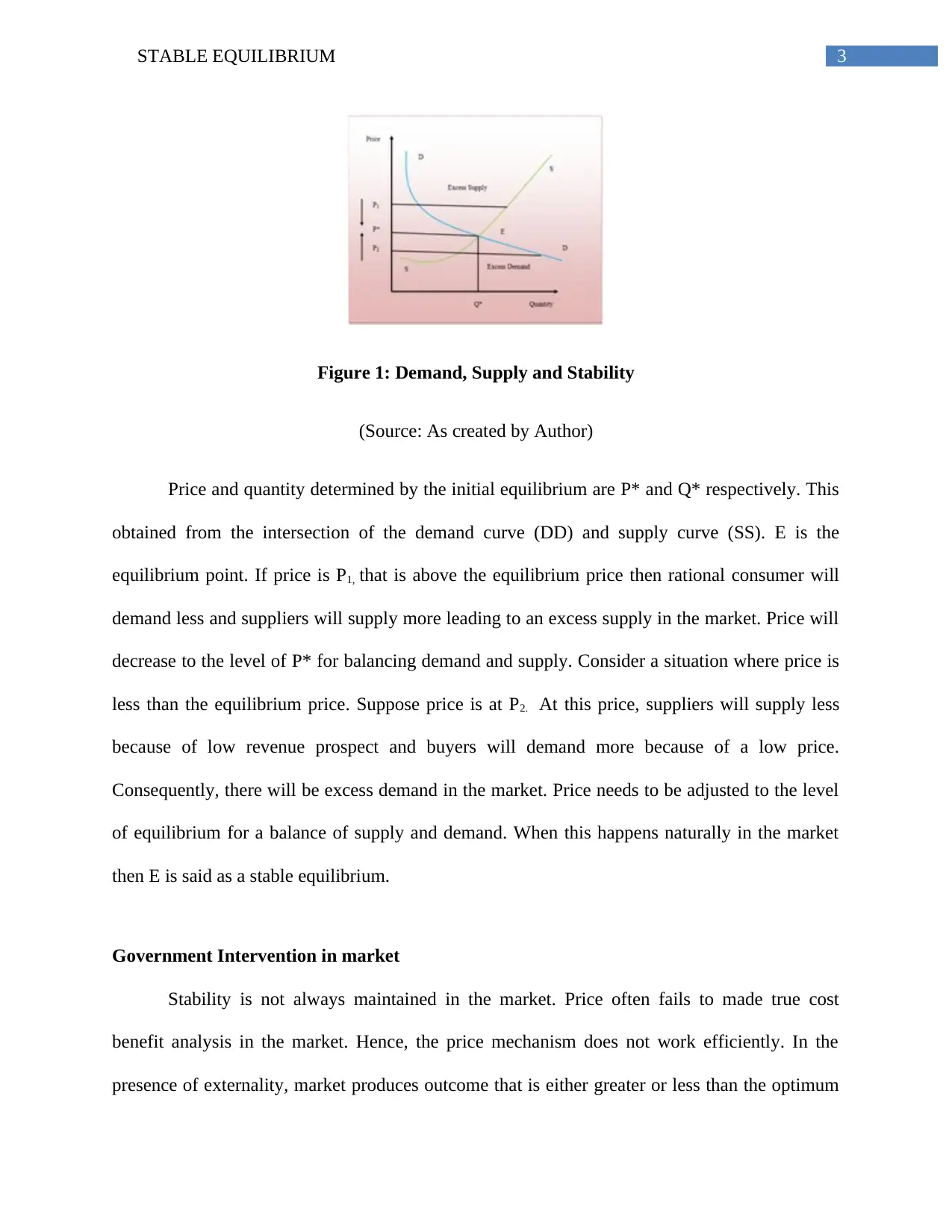
3STABLE EQUILIBRIUM
Figure 1: Demand, Supply and Stability
(Source: As created by Author)
Price and quantity determined by the initial equilibrium are P* and Q* respectively. This
obtained from the intersection of the demand curve (DD) and supply curve (SS). E is the
equilibrium point. If price is P1, that is above the equilibrium price then rational consumer will
demand less and suppliers will supply more leading to an excess supply in the market. Price will
decrease to the level of P* for balancing demand and supply. Consider a situation where price is
less than the equilibrium price. Suppose price is at P2. At this price, suppliers will supply less
because of low revenue prospect and buyers will demand more because of a low price.
Consequently, there will be excess demand in the market. Price needs to be adjusted to the level
of equilibrium for a balance of supply and demand. When this happens naturally in the market
then E is said as a stable equilibrium.
Government Intervention in market
Stability is not always maintained in the market. Price often fails to made true cost
benefit analysis in the market. Hence, the price mechanism does not work efficiently. In the
presence of externality, market produces outcome that is either greater or less than the optimum
Figure 1: Demand, Supply and Stability
(Source: As created by Author)
Price and quantity determined by the initial equilibrium are P* and Q* respectively. This
obtained from the intersection of the demand curve (DD) and supply curve (SS). E is the
equilibrium point. If price is P1, that is above the equilibrium price then rational consumer will
demand less and suppliers will supply more leading to an excess supply in the market. Price will
decrease to the level of P* for balancing demand and supply. Consider a situation where price is
less than the equilibrium price. Suppose price is at P2. At this price, suppliers will supply less
because of low revenue prospect and buyers will demand more because of a low price.
Consequently, there will be excess demand in the market. Price needs to be adjusted to the level
of equilibrium for a balance of supply and demand. When this happens naturally in the market
then E is said as a stable equilibrium.
Government Intervention in market
Stability is not always maintained in the market. Price often fails to made true cost
benefit analysis in the market. Hence, the price mechanism does not work efficiently. In the
presence of externality, market produces outcome that is either greater or less than the optimum
Paraphrase This Document
Need a fresh take? Get an instant paraphrase of this document with our AI Paraphraser
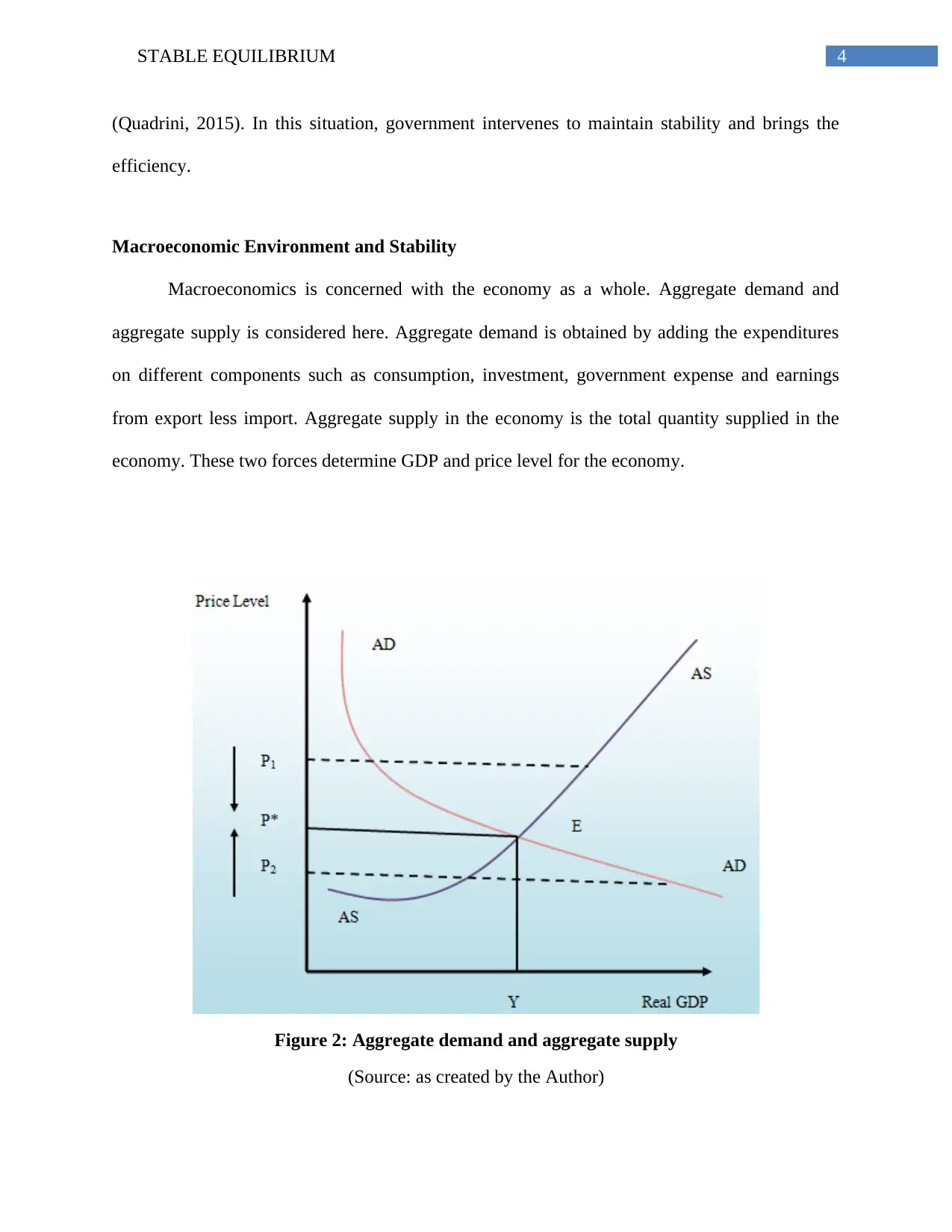
4STABLE EQUILIBRIUM
(Quadrini, 2015). In this situation, government intervenes to maintain stability and brings the
efficiency.
Macroeconomic Environment and Stability
Macroeconomics is concerned with the economy as a whole. Aggregate demand and
aggregate supply is considered here. Aggregate demand is obtained by adding the expenditures
on different components such as consumption, investment, government expense and earnings
from export less import. Aggregate supply in the economy is the total quantity supplied in the
economy. These two forces determine GDP and price level for the economy.
Figure 2: Aggregate demand and aggregate supply
(Source: as created by the Author)
(Quadrini, 2015). In this situation, government intervenes to maintain stability and brings the
efficiency.
Macroeconomic Environment and Stability
Macroeconomics is concerned with the economy as a whole. Aggregate demand and
aggregate supply is considered here. Aggregate demand is obtained by adding the expenditures
on different components such as consumption, investment, government expense and earnings
from export less import. Aggregate supply in the economy is the total quantity supplied in the
economy. These two forces determine GDP and price level for the economy.
Figure 2: Aggregate demand and aggregate supply
(Source: as created by the Author)
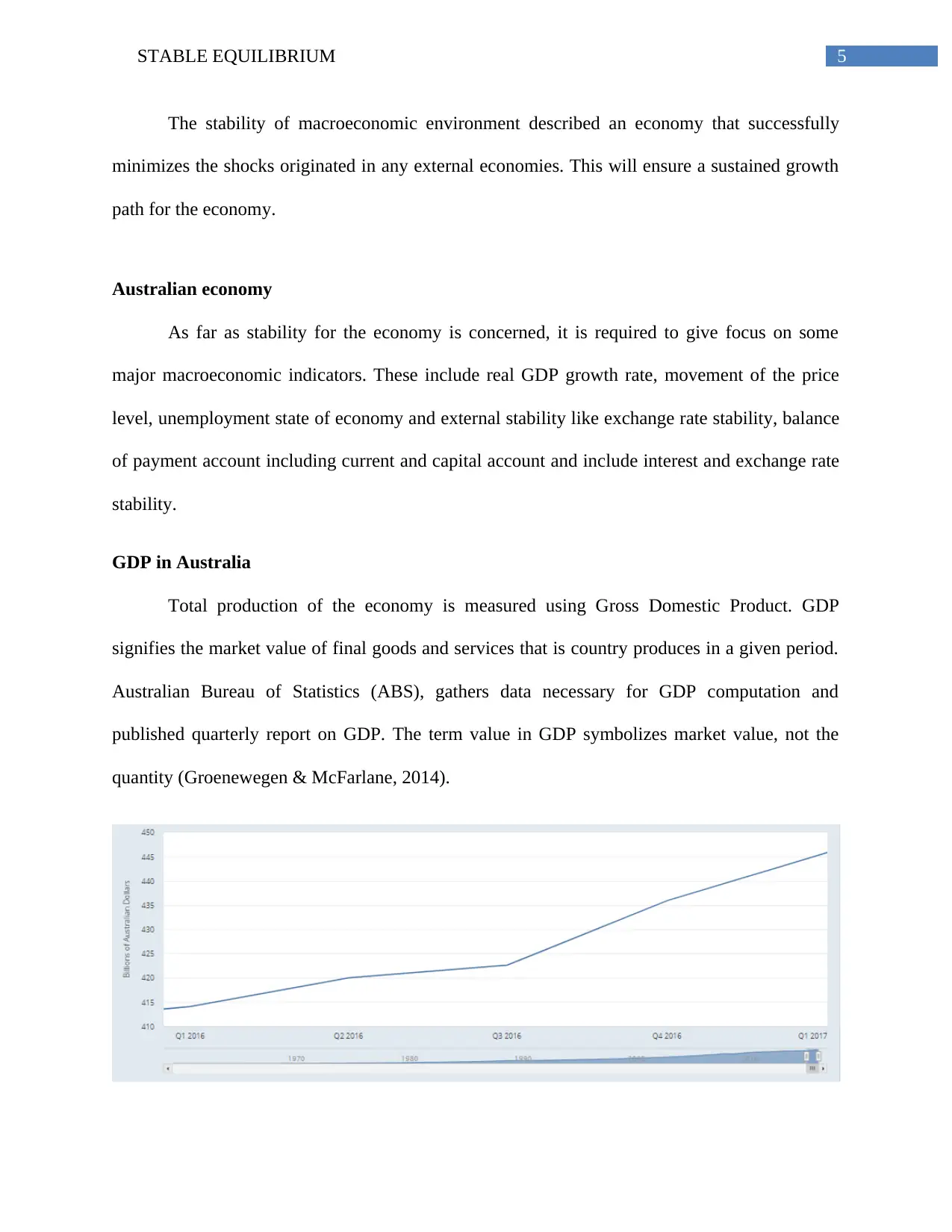
5STABLE EQUILIBRIUM
The stability of macroeconomic environment described an economy that successfully
minimizes the shocks originated in any external economies. This will ensure a sustained growth
path for the economy.
Australian economy
As far as stability for the economy is concerned, it is required to give focus on some
major macroeconomic indicators. These include real GDP growth rate, movement of the price
level, unemployment state of economy and external stability like exchange rate stability, balance
of payment account including current and capital account and include interest and exchange rate
stability.
GDP in Australia
Total production of the economy is measured using Gross Domestic Product. GDP
signifies the market value of final goods and services that is country produces in a given period.
Australian Bureau of Statistics (ABS), gathers data necessary for GDP computation and
published quarterly report on GDP. The term value in GDP symbolizes market value, not the
quantity (Groenewegen & McFarlane, 2014).
The stability of macroeconomic environment described an economy that successfully
minimizes the shocks originated in any external economies. This will ensure a sustained growth
path for the economy.
Australian economy
As far as stability for the economy is concerned, it is required to give focus on some
major macroeconomic indicators. These include real GDP growth rate, movement of the price
level, unemployment state of economy and external stability like exchange rate stability, balance
of payment account including current and capital account and include interest and exchange rate
stability.
GDP in Australia
Total production of the economy is measured using Gross Domestic Product. GDP
signifies the market value of final goods and services that is country produces in a given period.
Australian Bureau of Statistics (ABS), gathers data necessary for GDP computation and
published quarterly report on GDP. The term value in GDP symbolizes market value, not the
quantity (Groenewegen & McFarlane, 2014).
⊘ This is a preview!⊘
Do you want full access?
Subscribe today to unlock all pages.

Trusted by 1+ million students worldwide
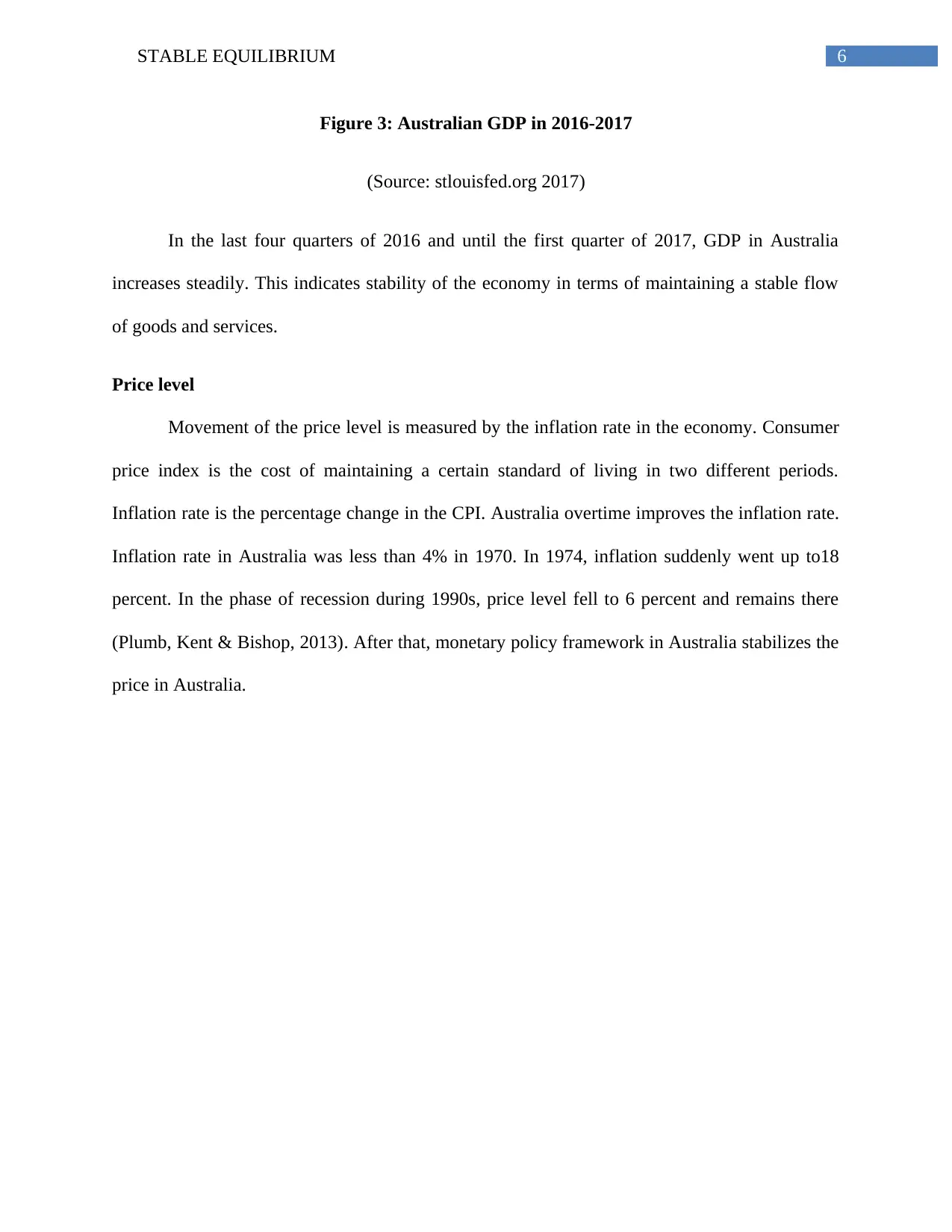
6STABLE EQUILIBRIUM
Figure 3: Australian GDP in 2016-2017
(Source: stlouisfed.org 2017)
In the last four quarters of 2016 and until the first quarter of 2017, GDP in Australia
increases steadily. This indicates stability of the economy in terms of maintaining a stable flow
of goods and services.
Price level
Movement of the price level is measured by the inflation rate in the economy. Consumer
price index is the cost of maintaining a certain standard of living in two different periods.
Inflation rate is the percentage change in the CPI. Australia overtime improves the inflation rate.
Inflation rate in Australia was less than 4% in 1970. In 1974, inflation suddenly went up to18
percent. In the phase of recession during 1990s, price level fell to 6 percent and remains there
(Plumb, Kent & Bishop, 2013). After that, monetary policy framework in Australia stabilizes the
price in Australia.
Figure 3: Australian GDP in 2016-2017
(Source: stlouisfed.org 2017)
In the last four quarters of 2016 and until the first quarter of 2017, GDP in Australia
increases steadily. This indicates stability of the economy in terms of maintaining a stable flow
of goods and services.
Price level
Movement of the price level is measured by the inflation rate in the economy. Consumer
price index is the cost of maintaining a certain standard of living in two different periods.
Inflation rate is the percentage change in the CPI. Australia overtime improves the inflation rate.
Inflation rate in Australia was less than 4% in 1970. In 1974, inflation suddenly went up to18
percent. In the phase of recession during 1990s, price level fell to 6 percent and remains there
(Plumb, Kent & Bishop, 2013). After that, monetary policy framework in Australia stabilizes the
price in Australia.
Paraphrase This Document
Need a fresh take? Get an instant paraphrase of this document with our AI Paraphraser
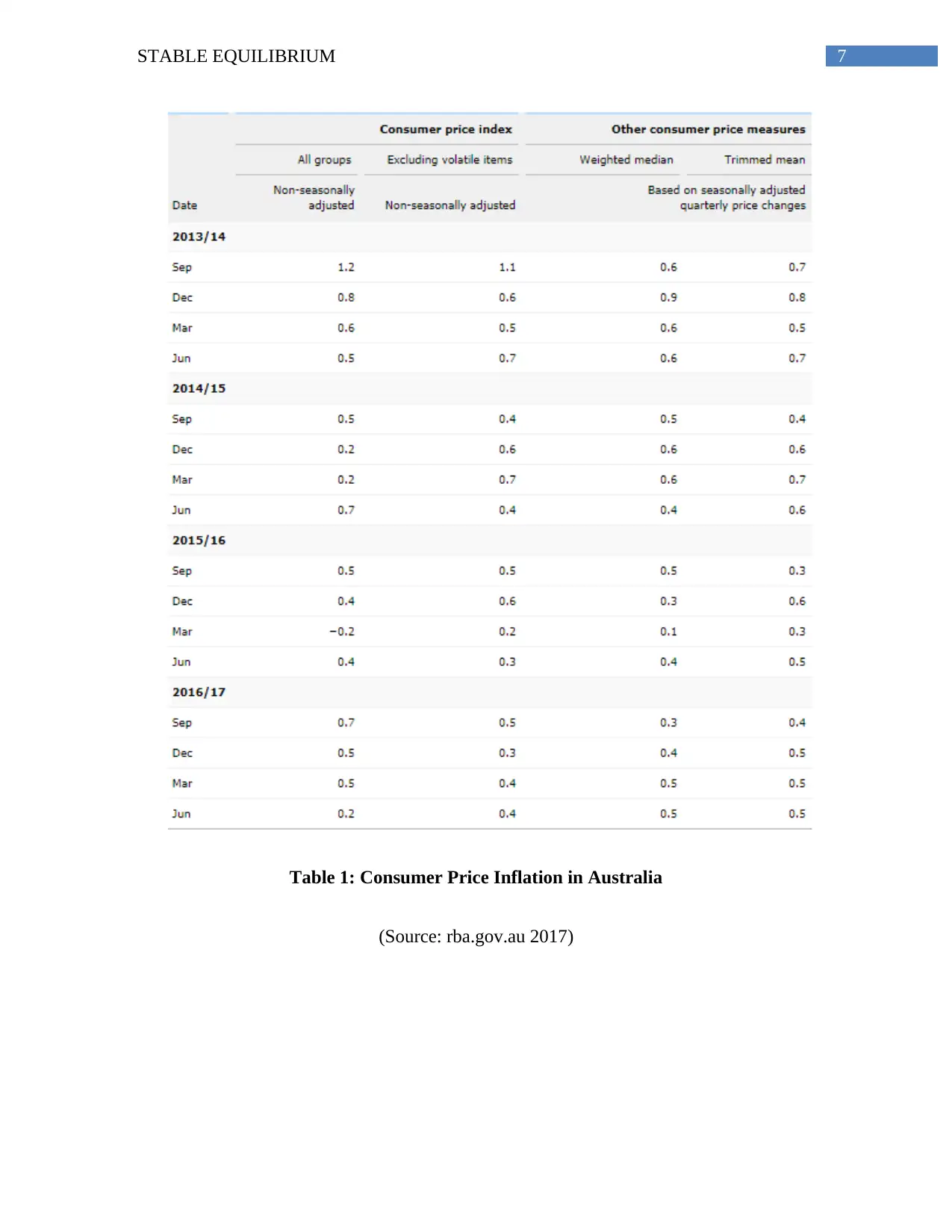
7STABLE EQUILIBRIUM
Table 1: Consumer Price Inflation in Australia
(Source: rba.gov.au 2017)
Table 1: Consumer Price Inflation in Australia
(Source: rba.gov.au 2017)
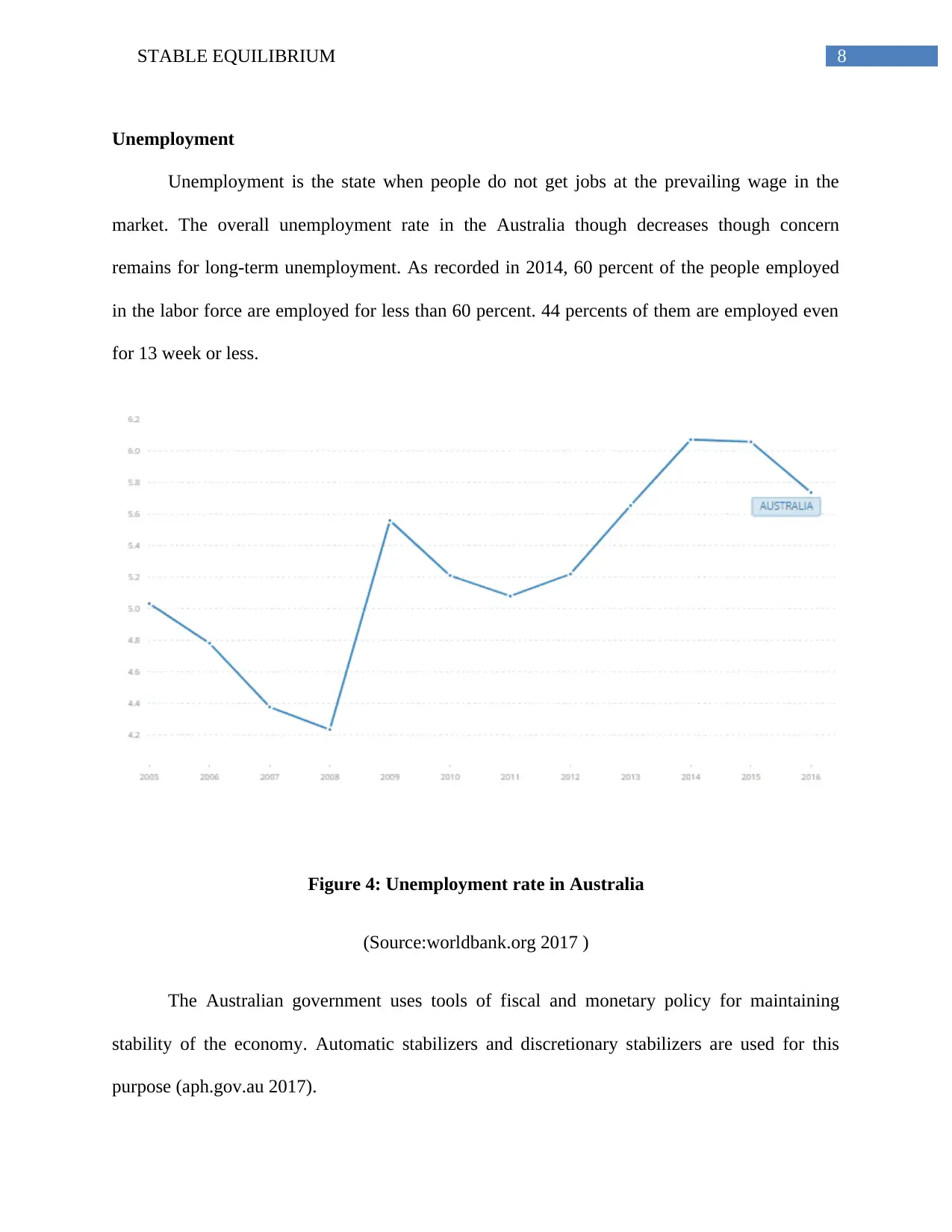
8STABLE EQUILIBRIUM
Unemployment
Unemployment is the state when people do not get jobs at the prevailing wage in the
market. The overall unemployment rate in the Australia though decreases though concern
remains for long-term unemployment. As recorded in 2014, 60 percent of the people employed
in the labor force are employed for less than 60 percent. 44 percents of them are employed even
for 13 week or less.
Figure 4: Unemployment rate in Australia
(Source:worldbank.org 2017 )
The Australian government uses tools of fiscal and monetary policy for maintaining
stability of the economy. Automatic stabilizers and discretionary stabilizers are used for this
purpose (aph.gov.au 2017).
Unemployment
Unemployment is the state when people do not get jobs at the prevailing wage in the
market. The overall unemployment rate in the Australia though decreases though concern
remains for long-term unemployment. As recorded in 2014, 60 percent of the people employed
in the labor force are employed for less than 60 percent. 44 percents of them are employed even
for 13 week or less.
Figure 4: Unemployment rate in Australia
(Source:worldbank.org 2017 )
The Australian government uses tools of fiscal and monetary policy for maintaining
stability of the economy. Automatic stabilizers and discretionary stabilizers are used for this
purpose (aph.gov.au 2017).
⊘ This is a preview!⊘
Do you want full access?
Subscribe today to unlock all pages.

Trusted by 1+ million students worldwide
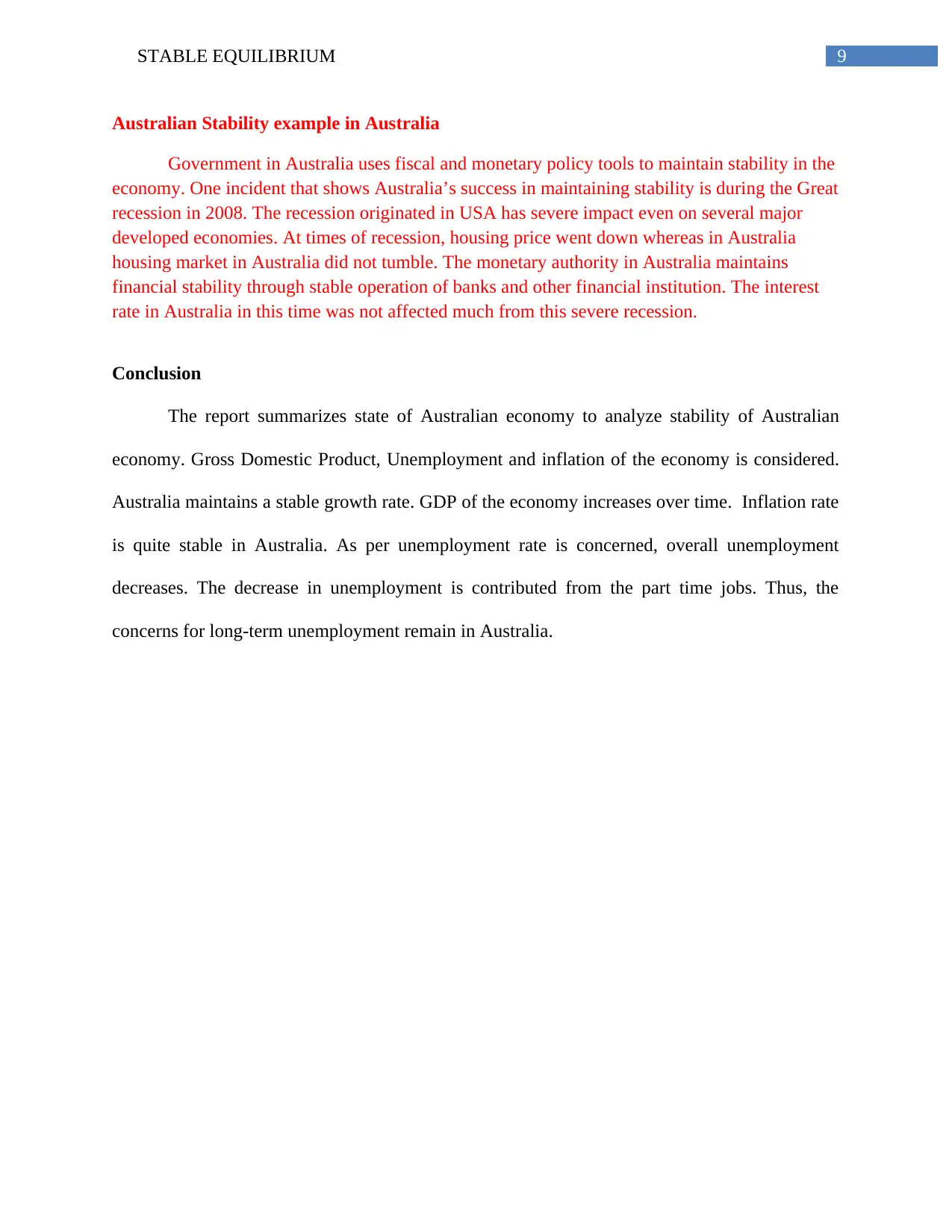
9STABLE EQUILIBRIUM
Australian Stability example in Australia
Government in Australia uses fiscal and monetary policy tools to maintain stability in the
economy. One incident that shows Australia’s success in maintaining stability is during the Great
recession in 2008. The recession originated in USA has severe impact even on several major
developed economies. At times of recession, housing price went down whereas in Australia
housing market in Australia did not tumble. The monetary authority in Australia maintains
financial stability through stable operation of banks and other financial institution. The interest
rate in Australia in this time was not affected much from this severe recession.
Conclusion
The report summarizes state of Australian economy to analyze stability of Australian
economy. Gross Domestic Product, Unemployment and inflation of the economy is considered.
Australia maintains a stable growth rate. GDP of the economy increases over time. Inflation rate
is quite stable in Australia. As per unemployment rate is concerned, overall unemployment
decreases. The decrease in unemployment is contributed from the part time jobs. Thus, the
concerns for long-term unemployment remain in Australia.
Australian Stability example in Australia
Government in Australia uses fiscal and monetary policy tools to maintain stability in the
economy. One incident that shows Australia’s success in maintaining stability is during the Great
recession in 2008. The recession originated in USA has severe impact even on several major
developed economies. At times of recession, housing price went down whereas in Australia
housing market in Australia did not tumble. The monetary authority in Australia maintains
financial stability through stable operation of banks and other financial institution. The interest
rate in Australia in this time was not affected much from this severe recession.
Conclusion
The report summarizes state of Australian economy to analyze stability of Australian
economy. Gross Domestic Product, Unemployment and inflation of the economy is considered.
Australia maintains a stable growth rate. GDP of the economy increases over time. Inflation rate
is quite stable in Australia. As per unemployment rate is concerned, overall unemployment
decreases. The decrease in unemployment is contributed from the part time jobs. Thus, the
concerns for long-term unemployment remain in Australia.
Paraphrase This Document
Need a fresh take? Get an instant paraphrase of this document with our AI Paraphraser
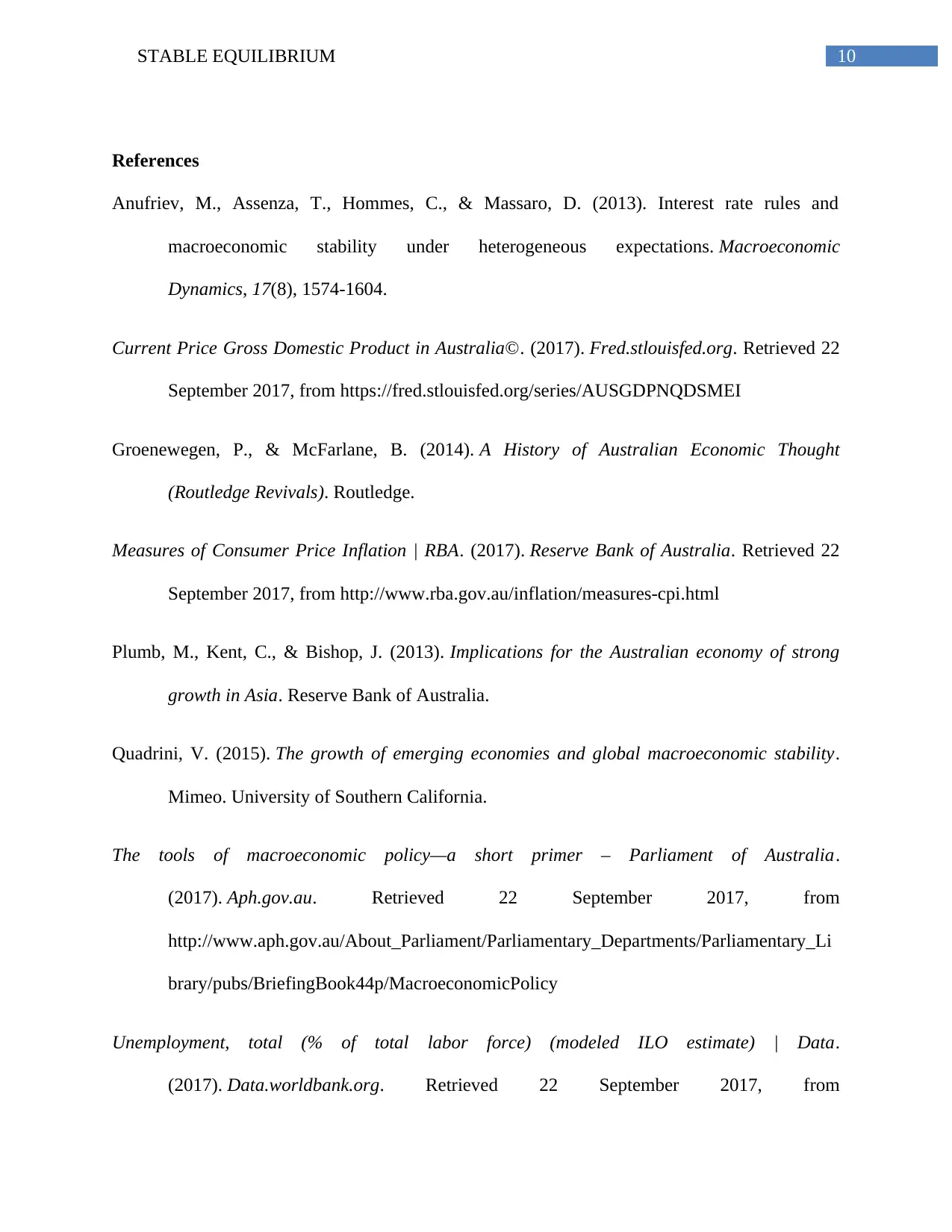
10STABLE EQUILIBRIUM
References
Anufriev, M., Assenza, T., Hommes, C., & Massaro, D. (2013). Interest rate rules and
macroeconomic stability under heterogeneous expectations. Macroeconomic
Dynamics, 17(8), 1574-1604.
Current Price Gross Domestic Product in Australia©. (2017). Fred.stlouisfed.org. Retrieved 22
September 2017, from https://fred.stlouisfed.org/series/AUSGDPNQDSMEI
Groenewegen, P., & McFarlane, B. (2014). A History of Australian Economic Thought
(Routledge Revivals). Routledge.
Measures of Consumer Price Inflation | RBA. (2017). Reserve Bank of Australia. Retrieved 22
September 2017, from http://www.rba.gov.au/inflation/measures-cpi.html
Plumb, M., Kent, C., & Bishop, J. (2013). Implications for the Australian economy of strong
growth in Asia. Reserve Bank of Australia.
Quadrini, V. (2015). The growth of emerging economies and global macroeconomic stability.
Mimeo. University of Southern California.
The tools of macroeconomic policy—a short primer – Parliament of Australia.
(2017). Aph.gov.au. Retrieved 22 September 2017, from
http://www.aph.gov.au/About_Parliament/Parliamentary_Departments/Parliamentary_Li
brary/pubs/BriefingBook44p/MacroeconomicPolicy
Unemployment, total (% of total labor force) (modeled ILO estimate) | Data.
(2017). Data.worldbank.org. Retrieved 22 September 2017, from
References
Anufriev, M., Assenza, T., Hommes, C., & Massaro, D. (2013). Interest rate rules and
macroeconomic stability under heterogeneous expectations. Macroeconomic
Dynamics, 17(8), 1574-1604.
Current Price Gross Domestic Product in Australia©. (2017). Fred.stlouisfed.org. Retrieved 22
September 2017, from https://fred.stlouisfed.org/series/AUSGDPNQDSMEI
Groenewegen, P., & McFarlane, B. (2014). A History of Australian Economic Thought
(Routledge Revivals). Routledge.
Measures of Consumer Price Inflation | RBA. (2017). Reserve Bank of Australia. Retrieved 22
September 2017, from http://www.rba.gov.au/inflation/measures-cpi.html
Plumb, M., Kent, C., & Bishop, J. (2013). Implications for the Australian economy of strong
growth in Asia. Reserve Bank of Australia.
Quadrini, V. (2015). The growth of emerging economies and global macroeconomic stability.
Mimeo. University of Southern California.
The tools of macroeconomic policy—a short primer – Parliament of Australia.
(2017). Aph.gov.au. Retrieved 22 September 2017, from
http://www.aph.gov.au/About_Parliament/Parliamentary_Departments/Parliamentary_Li
brary/pubs/BriefingBook44p/MacroeconomicPolicy
Unemployment, total (% of total labor force) (modeled ILO estimate) | Data.
(2017). Data.worldbank.org. Retrieved 22 September 2017, from

11STABLE EQUILIBRIUM
https://data.worldbank.org/indicator/SL.UEM.TOTL.ZS?
end=2016&locations=AU&start=2005&view=chart
https://data.worldbank.org/indicator/SL.UEM.TOTL.ZS?
end=2016&locations=AU&start=2005&view=chart
⊘ This is a preview!⊘
Do you want full access?
Subscribe today to unlock all pages.

Trusted by 1+ million students worldwide
1 out of 12
Related Documents
Your All-in-One AI-Powered Toolkit for Academic Success.
+13062052269
info@desklib.com
Available 24*7 on WhatsApp / Email
![[object Object]](/_next/static/media/star-bottom.7253800d.svg)
Unlock your academic potential
Copyright © 2020–2025 A2Z Services. All Rights Reserved. Developed and managed by ZUCOL.





